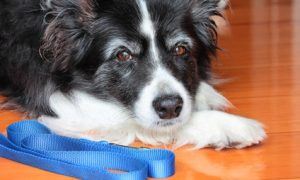“This post contains affiliate links, and I will be compensated if you make a purchase after clicking on my links.”
Have you noticed your once lively pup beginning to slow down? Maybe he’s limping, or slow to get up and down. If your dog is a large or giant breed, there’s a chance he could be feeling the effects of canine hip dysplasia. Although the disease can affect any breed, it is most common in larger breeds.
A visit to your veterinarian can confirm HD and start a course of action for making your pup lively again. We found some great information about hip dysplasia and its treatment from Dr. Milwicki.
Health Topics: Canine Hip Dysplasia
Most dog owners have at one time or another, gone through the process of purchasing or adopting a new puppy. We pay close attention to their personality, the color and texture of their coat, long hair or short, bold or timid etc. etc. But what about those hidden traits? What is lurking within that cute, cuddly ball of fur that’s going to cause us heartache a few years down the road?
Since none of us have a crystal ball (well not one that works anyway), we have to base our decision on whatever information is available at the time. Does the pup appear healthy? What do the parents look like and are they showing any signs of a genetic disease? If there is a history of a particular disease in this breed, could it be that this playful pup now sleeping in your arms, is one day going to develop a crippling illness?
While there are no guarantees, even with all the certificates and other papers that accompany the new dog, we should all at least be aware of the most common genetic disease – Hip Dysplasia (HD).
Despite more than twenty five years of organized effort to eliminate this disease, more than a third of all cases seen by veterinary orthopedists have joint disease related to HD. Although any breed can be affected, it is usually more prevalent in the large and giant breeds. Dysplastic pups are actually born with normal hips – this is a genetic disease, not a congenital one- and then gradually between six and twenty four months, the dysplasia becomes evident.
The actual cause of HD is basically unknown, but it is believed that certain environmental and nutritional factors play a significant role in its development. Heavy supplementation with vitamins and minerals together with free choice of puppy food often leads to very rapid growth or obesity, and to the clinical symptoms of HD. Typically, signs include limping, getting up or lying down very slowly, difficulty with stairs and stiffness which gradually improves with exercise. While some of these signs could indicate other problems, a consultation with your veterinarian is essential to determine the exact cause of discomfort. Its important to note that HD doesn’t develop suddenly – it starts off with very mild symptoms and gradually worsens over a period of months.
In diagnosing the condition, your veterinarian will carefully manipulate the dog’s hips to detect any discomfort or “looseness” in the joints. In most cases X-rays are needed, usually with the patient under sedation, to confirm the diagnosis and determine how severe the condition is. Treatments for HD will vary depending upon a number of factors including the age of the dog, the degree of dysplasia and arthritis present in the joint, the amount of discomfort shown as well as the owners preferences. In mild cases, conservative treatment is certainly the best option. If the dog can still run, jump and play normally, this should be the treatment of choice. Three factors are involved here:
1) Weight control
2) Anti-inflammatory drugs
3) Exercise restrictionIt is critical to discuss these three factors with your veterinarian and obtain guidelines regarding optimum weight for your pet and also which medications would be most beneficial.
In more severe cases, surgery is indicated to relieve the discomfort and to allow the dog to resume most of its normal activities. Three primary surgical procedures are available. Your veterinarian or veterinary orthopedic surgeon will determine which one will best suit your pet. Briefly these are:
1) Replacing the natural joint, or total hip replacement
2) Removing the natural joint, or femoral head resection
3) Saving the natural joint, or triple pelvic osteotomy.While hip dysplasia can be a very debilitating disease, especially in the larger breeds, there are methods of treatment available to help your pet enjoy a happy, pain-free life.
Do you have a dog suffering from Canine Hip Dysplasia? What were his symptoms and how do you treat this painful disease? Tell us about it below!




















Adequan has been used for horses for years, and was approved for dogs in 1997, yet not widely known.